|
|
| home > files |
| Zaha
Hadid's Contemporary Arts Center, Cincinnati, OH Kay Bea Jones |
| [in italiano] | Contemporary
Art Centers seem to be appearing everywhere in recent years. Most centers
open to fanfare and acclaim for provocative new or rehabbed spaces,
and are often first featured without any art to clutter them up. Not
so with the Contemporary Arts Center by Zaha Hadid and KZF. The premiere
celebration for the Cincinnati building 8 years in the making took place
on May 31 hosting the inaugural exhibition curated by Thom Collins called,
"Somewhere Better Than This Place: Alternative Social Experience in
the Spaces of Contemporary Art." But at that particular moment, there
was nowhere better than that place. The thousands who attended the street party celebration were in obvious agreement. Elbow to elbow, we were swept inside by the urban carpet onto the slow black stair that zigzagged among the six gallery levels to inhabit the jigsaw puzzle of intermingling notched rooms for art. While the public anxiously anticipated the new CAC, several international exhibits and publications featured Hadid's design. She continually revised the building throughout its slow evolution, so no two demonstrations of her proposal elicit the same set of plans. The resulting corner building can be seen to have developed from a transparent glass assemblage of floating volumes into a composition of dark and light solid masses hovering over the downtown intersection. |
[10jul2003] | ||
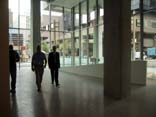
|
When her proposal appeared among twenty-five projects highlighted in
'Museums for a New Millennium' (2000-2003), we examined the ideas by
way of digital perspective renderings and a plexiglass model, but no
plan or section drawings were shown. One understands essentially that
the plan is not the primary generator when experiencing Hadid's buildings,
and her artful integration of dissimilar spaces would not be evident
in traditional graphic renderings. The ultimate CAC experience is labyrinthine,
wholly evocative, sensually sublime, yet somehow comfortably familiar. |
|||
| With
her Cincinnati building , Hadid may have defined the contemporary gallery
species for new art, a creature sought by so many current architects,
but actually embraced by so few. Her art center embodies the vary characteristics
that Gianni Vattimo reminded us we seek in an encounter with a work
of art, "to experience in the imagination forms of existence and ways
of life different from the one in which we have become immersed in our
own concrete everydayness." |
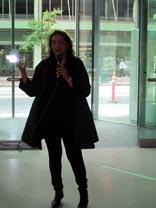
|
|||
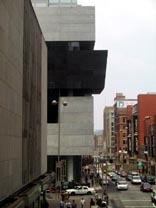
|
The
CAC is tied to its downtown Cincinnati site with sophisticated formal
and visual connections to the everyday urban experience. Approached
from Walnut or Sixth Streets, the ominous black cantilever jutting four
floors over the sidewalk announces arrival. The setback storefront corner
wrapped in glass facilitates the mutual gaze within and without. Visitors
are drawn in by the spectacle and sunlight reflecting off the rear concrete
interior façade. Tight canted stairs to the lower performance level
offer another view of passers by upon descent, while the monumental
ascent up the black promenade gives sequential, repeated views of street
life from different levels. Alternate stair landings focus the view
onto the corner plaza across Walnut Street at the south end of the Aronoff
Performing Arts Center. Eventually Mount Adams is framed to the east. |
|||
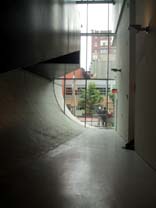 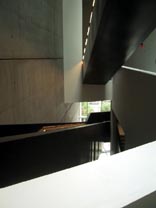
|
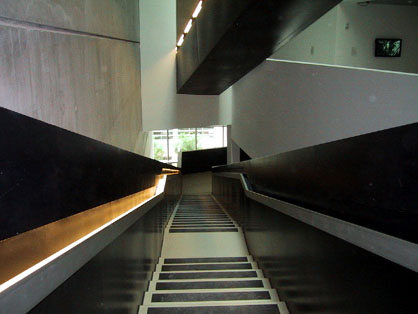 Hadid skillfully appropriated the adjacent urban space to feature her façade composition of black, white and void elements. Two levels of offices hug the street on the south side behind a curtain wall of glass, while the galleries inhabit solid forms and look inward. Two extraordinary panoramas re-present Cincinnati to arts observers: one from the executive level terrace above the black cantilever, and the other from the UnMuseum (kid's gallery) window on the top floor. The terrace view stretches over Walnut Street to offer a captured view of the Ohio River to the south. The corner view from the children's museum located at the pinnacle of the black promenade is a fitting conclusion to the long sequence. Although the panoramic window is adult height, and grown ups see rooftop views of Cincinnati's skyscrapers and highrises, children can watch passing clouds. |
|||
| With
each iteration of the CAC project, a total malleability of forms, fabric,
and facades begins to emerge. Yet as the building took shape from an
early concept for the Center to reality, Hadid's articulation of her
thesis remained the same: openness to the street would connect cultural
life and contemporary art to civic life and the citizens of Cincinnati
(thus the urban carpet motif), and long, short, broad and tall gallery
volumes with variable light conditions would inspire the possibilities
for delivering new art (thus the jigsaw puzzle motif). On her terms,
successful galleries with curatorial flexibility need not require bland
and banal spaces or anonymous white boxes. Daylight was Hadid's primary
form-generating element, and as she said at the CAC press conference,
her 8 years working in Cincinnati taught her about the local quality
of light. Her lessons are everywhere apparent. Variable sunshine and
shade bring greater or lesser quantities of daylight into the lobby
from the southeast street exposure and through the overhead skylight
to illuminate the rear concrete wall. The black stair is silhouetted
against a background of changing intensity. Reflected light enters adjacent
galleries and orients visitors along the museum sequence. |
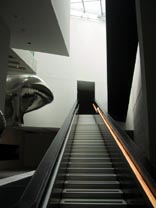
|
|||
| The
UnMuseum, which places children on top and offers interactive engagement
with artifacts, has views into the glass-enclosed courtyard/staiwell.
Kids are positioned between the city beyond and the center within. |
||||
| The
CAC offers sensual pleasures that range from the big, bright views to
the black wood of the performance theater and the cool concrete carpet
bathed in hot slices of daylight. Hadid's material choices are consistent
with the artful composition of spatial relations, and make the total
composition viscerally complete and wholly satisfying. Even the artworks
appear at home. Alternative social experiences as depicted by Patty
Chang, Groovisions, Moshekwe Langa, Nikki Lee, T.J. Wilcox, Zhang Huan,
Inigo Mangloano-Ovalle, Mark Lombardi, John Armleder, Janet Cardiff
among the 37 artists whose work appeared in the inaugural exhibition,
removed us from our concrete everydayness to emerge transformed. Or
maybe that was the architecture... Kay Bea Jones jones.76@osu.edu |
||||